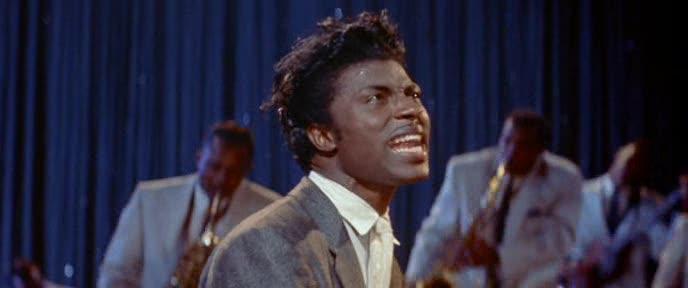Shelf Life is a weekly feature that selects a film currently on DVD/Blu-Ray for review.
The carefully ordered chaos of Frank Tashlin’s work has rarely been so concisely summarized than in the introduction to his 1956 feature The Girl Can’t Help It. Like the fake ads that dot the start of the masterpiece Tashlin made the following year, Will Success Spoil Rock Hunter, The Girl Can’t Help It doesn’t allow the audience to get settled before steeping them in artifice. In Academy ratio black-and-white, Tom Miller (Tom Ewell) welcomes the audience before he takes control of the frame itself, expanding the aspect ratio into 2.35:1 CinemaScope and fading in the Deluxecolor to paint the strange background of musical instruments suspended in mid-air.
That sense of control, however, almost instantly vanishes in the feature that follows, which starts as a sexpot comedy riff on Marilyn Monroe and ends a celebration of the rock ‘n’ roll it pokes fun at throughout. The instruments behind Miller’s odd but still formal introduction—harps, double-basses, saxophones, grand pianos—mostly appear in use in the film proper, but in their suspended animation, they seem like relics of the past. Their glint of glamour links them to light jazz and postwar club music, but it is in their vulgarization at the hands of rock musicians that these instruments find a life free of that frozen perfection.
Ostensibly, the film concerns Miller, a press agent who used to be a starmaker but now mopes around seeing sultry visions of the singer (Julie London) he promoted but could not love out of principle. Miller gets drawn back into his work by a gangster, Fats Murdock (Edmond O’Brien), who wants Miller to turn his girlfriend, Jerri (Jayne Mansfield), into a star. One wonders why she even needs an agent: walking down the street, Mansfield’s absurd proportions trigger a spate of sexualized gags from gawking men, including bottles of milk boiling and flowing over in fellas’ hands.
Underneath Mansfield’s sexpot image, though, is a woman who yearns simply to be a homemaker; indeed, her cooking impresses Miller as much as her looks, and much more than her (seeming) inability to sing. Tashlin deconstructs a reductive touchstone of ‘50s pop culture, albeit only to place the person trapped by that image into an equally dated one. That transition between dull, confining types is indicative of the film’s principal cast. Murdock himself is out of date: we see his rise and fall through an amusing montage of newsreel footage that the gangster watches like a video a football coach keeps of that disastrous championship choke. At the start of the clips, Murdock is a lean, mean terror of the streets, a vision out of a Pre-Code film; by the end, he’s just washed-up ol’ “Fats.” Like those jazz instruments that feel so lifeless strung from the ceiling by wires, core elements of American pop culture (by its nature white-centric) ossify before our eyes.
But if Tashlin wanted to mock the budding rock scene as well—likely, given his depiction of vacuous teenyboppers and label heads as the next wave of manipulative, vice-doling gangsters (complete with jukeboxes being smashed in clubs like so many barrels of the other guy’s bootleg booze)—the music defies his satiric control. Though The Girl Can’t Help It features a multiracial blend of early rock artists, the music itself exists outside a white culture that has yet to appropriate it. Little Richard shows up dressed so outlandishly one wonders if Tashlin had to make the colors and mise-en-scène in the rest of the movie so wild just to match him. Even a white boy like Eddie Cochran can set Murdock’s black maid to dancing without shame in front of white guests, a kind of liberation through pop that hints at breakthroughs the most uncompromising jazz of the period could not effect.
Murdock, like some old rivals, gets in on the rock game for easy money, but the menace it returns to this has-been street tyrant shows the music, not the mobsters, is the social embodiment of danger. The same bleaching that befell the stuffy jazz used for juxtaposition in this film would eventually take rock, too, but The Girl Can’t Help It illustrates the raw promise of rock ‘n’ roll in a way that has never been equalled.
The Girl Can’t Help It is available on Region 1 DVD as part of the Jayne Mansfield Collection and as a stand-alone Region 2 DVD.



















